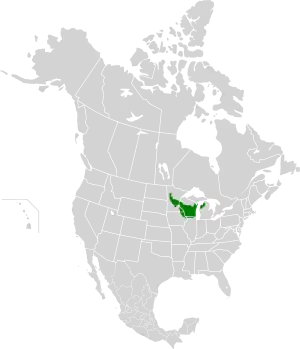Upper Midwest forest–savanna transition
The Upper Midwest forest–savanna transition is a terrestrial ecoregion that is defined by the World Wildlife Fund. An oak savanna plant community located in the Upper Midwest region of the United States, it is an ecotone (a transitional area) between the tallgrass prairies to the west and the temperate deciduous forests to the east. A part of the Upper Mississippi River basin, it is considered endangered with less than 5% of the original ecosystem remaining intact, due mostly to overgrazing and conversion to agriculture.[2]
| Upper Midwest forest–savanna transition | |
|---|---|
 Ecoregion Preserve (Devil's Lake State Park, Wisconsin) | |
 | |
| Ecology | |
| Realm | Nearctic |
| Biome | Temperate broadleaf and mixed forest |
| Borders | |
| Bird species | 215[1] |
| Mammal species | 62[1] |
| Geography | |
| Area | 166,100 km2 (64,100 sq mi) |
| Countries | United States and Canada |
| States/Provinces | Minnesota, Wisconsin, Michigan, Iowa, Ontario and Manitoba |
| Conservation | |
| Habitat loss | 62.5%[1] |
| Protected | 4.7%[1] |
Fire and disturbance
Historically, wildfire has been the primary driver and determinant of the forest dynamics in the plant community. Due to this the resulting canopy structure has been relatively sparse (the basal area ranges approximately from 4 to 29 meters hectare−1). Presence and biodiversity of plant species is largely controlled by the frequency of fire. Typical tallgrass prairie vegetation such as grasses, forbs, shrubs, and sedges, increase with an increase in the amount of fire, whereas tree density and basal area decrease.[3]
After European American settlement and the abandonment of fire as a land management regime, most savannas have been converted into closed canopy woodlands, with shade tolerant and fire-intolerant species dominating rather than the historic primary and secondary succession species dependent on fire.[4]
Species distribution
Trees:
- Quercus macrocarpa (Bur oak)
- Tilia americana (American basswood)
- Acer saccharum (Sugar maple)
- Quercus rubra (Red oak)
Intact habitat
A survey in 1985 concluded that only 26 square kilometres (10 sq mi) of oak savanna remain, roughly 0.02% of what is estimated to have existed at the time of European settlement. Highly dispersed and fragmented, none of the present habitat falls under the designation of National Forests but comes under the administration of the states' Department of Natural Resources organizations or federal entities such as the Fish and Wildlife Service. Remaining intact habitat areas include:[5]
- Devil's Lake State Park, on the Baraboo Range in south-central Wisconsin
- Savanna Army Depot in extreme northwestern Illinois
- Parts of the Upper Mississippi River National Wildlife and Fish Refuge in eastern Minnesota and western Wisconsin
- Richard J. Dorer Memorial Hardwood State Forest in the Driftless Area of southeastern Minnesota
- Whitewater State Park, also in the Driftless Area
- Necedah National Wildlife Refuge in central Wisconsin
- Horicon Marsh in southeastern Wisconsin
- Kettle Moraine State Forest in southeastern Wisconsin
See also
- List of ecoregions in the United States (WWF)
- Cedar Creek Ecosystem Science Reserve – an ecological research station specializing in fire ecology and its effects on oak savannas run by the University of Minnesota
- Big Woods
- Oak savanna
References
- Hoekstra, J. M.; Molnar, J. L.; Jennings, M.; Revenga, C.; Spalding, M. D.; Boucher, T. M.; Robertson, J. C.; Heibel, T. J.; Ellison, K. (2010). Molnar, J. L. (ed.). The Atlas of Global Conservation: Changes, Challenges, and Opportunities to Make a Difference. University of California Press. ISBN 978-0-520-26256-0.
- Benke, Arthur C.; Colbert E. Cushing (26 May 2005). Rivers of North America. Academic Press. ISBN 978-0-12-088253-3.
- Tester, John R. (1989). "Effects of fire frequency on oak savanna in east-central Minnesota" (PDF). Bulletin of the Torrey Botanical Club. 116 (2): 134–144. doi:10.2307/2997196. JSTOR 2997196. Retrieved 2010-06-04.
- Mabry, Catherine M.; L.A. Brudvig; R.C. Atwell (2010-06-15). "The confluence of landscape context and site-level management in determining Midwestern savanna and woodland breeding bird communities". Forest Ecology and Management. Elsevier B.V. 260 (1): 42–51. doi:10.1016/j.foreco.2010.03.028.
- "Upper Midwest forest-savanna transition". Terrestrial Ecoregions. World Wildlife Fund. Retrieved 2010-05-24.